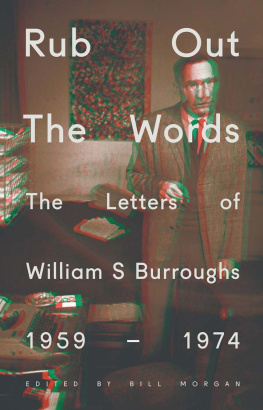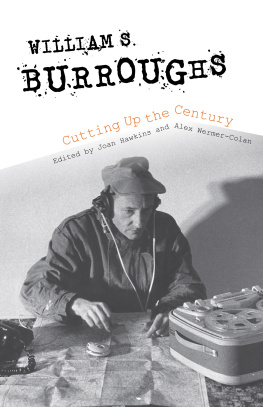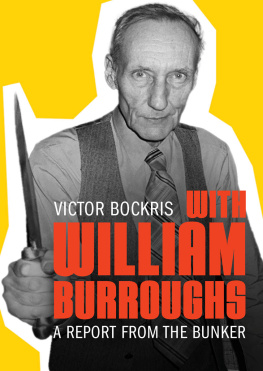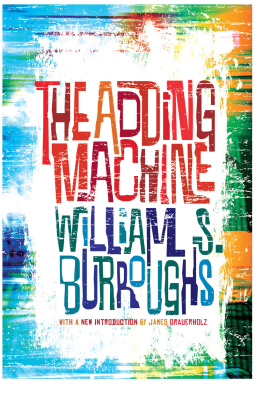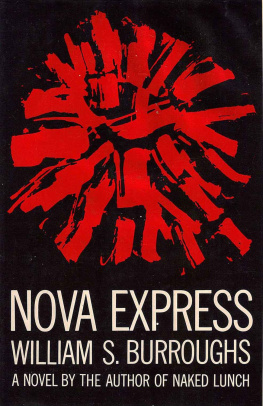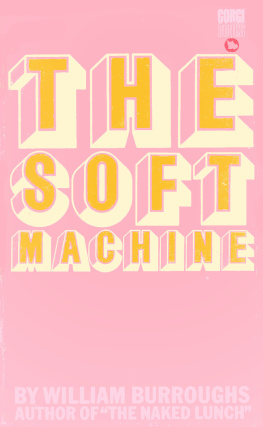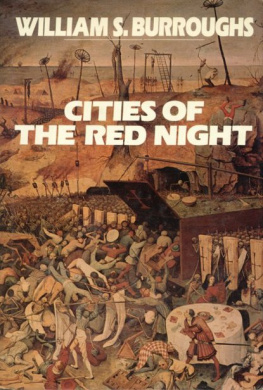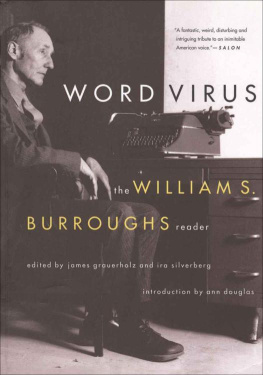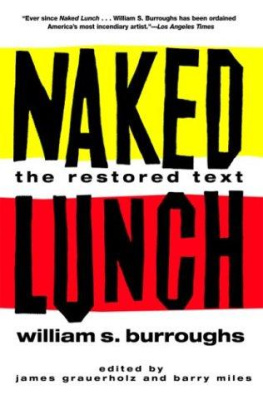William S. Burroughs & the Cult of Rock n Roll
Casey Rae

University of Texas Press
AUSTIN
Extracts from the William S. Burroughs works The Naked Lunch 1959 and Tornado Alley 1989 reprinted by kind permission of the William S. Burroughs Trust.
Copyright 2019 by Casey Rae
All rights reserved
First edition, 2019
Requests for permission to reproduce material from this work should be sent to:
Permissions
University of Texas Press
P.O. Box 7819
Austin, TX 78713-7819
utpress.utexas.edu/rp-form
Library of Congress Cataloging-in-Publication Data
Names: Rae, Casey, author.
Title: William S. Burroughs and the cult of rock n roll / Casey Rae.
Description: Austin : University of Texas Press, 2019. | Includes bibliographical references and index.
Identifiers: LCCN 2018035621
ISBN 978-1-4773-1650-4 (cloth : alk. paper)
ISBN 978-1-4773-1866-9 (library e-book)
ISBN 978-1-4773-1867-6 (non-library e-book)
Subjects: LCSH: Burroughs, William S., 1914-1997. | Burroughs, William S., 19141997Friends and associates. | Rock musicians.
Classification: LCC PS3552.U75 Z833 2018 | DDC 813/.54dc23
LC record available at https://lccn.loc.gov/2018035621
doi:10.7560/316504
For Sandy, among the stars
Contents
Introduction
Burroughs career is counted out in transformations.
There is no one Burroughs.
VICTOR BOCKRIS
In 1995, toward the end of his life, William S. Burroughs posed for a picture by Kate Simon, who had worked with him over a period of twenty years. The octogenarian author is seen smoking a joint beneath a large black-and-white screen with big block text that screams LIFE IS A KILLER. Burroughs celebrityor notorietywas primarily earned as the writer of such groundbreaking novels as Junkie, Naked Lunch, The Wild Boys, and Cities of the Red Night, along with countless articles, essays, and interviews. He also turned heads in the fine arts world with his infamous shotgun paintingswhich he made by blasting both barrels at a can of spray paint positioned near a plywood canvas affixed with collage. At age eighty-one, Burroughs was a living icon who had inspired countless younger artistsespecially musiciansover four decades of creative, psychological, and pharmacological exploration.
The most transgressive of the Beat writers, Burroughs was also something of a clandestine agent in the development of rock n rolla spectral figure who haunted the cultural underground and helped usher it into the mainstream. His direct impact on musical artists over a half century is immense but largely unexplored. From the Beatles, to punk, to todays remix scene, Burroughs helped accelerate an evolution in sound that continues to reverberate across continents and eras. This book tells the story of his personal connection to musicians and how his influence continues to echo more than twenty years after his death.
Burroughs still had plenty of spark at his final photo shoot, holding the pose for an extended period so Simon could properly frame him beneath a print made by his dear friend John Giorno. I thought the screen was beautiful, she remembered. He was smoking a joint. This was the last shot I took of him.... Its something; life is a killer. A potent statement, sharp and impossible to ignore, like a switchblade to the stomach. And true to boot. Born to Die isnt just the name of the second Lana Del Rey album: it is part of humanitys source code, which according to Burroughs was written onto our fleshy systems by an unseen and unperceivable operator that he called Control. All species are doomed from conception like all individuals, he said.
Burroughs spent his life researching and experimenting with ways to transform himself and the world around him. He did so through his writing as well as his work with audioboth of which inspired artists from Bob Dylan to Kurt Cobainhelping pave the way for todays sample- and remix-based music. Its strange to think of this Jazz Age relic, whose gentlemanly manners belied an uncompromising intellect, having an impact on so many different genres. Still, there is little doubt that the music of the twentieth century and beyond owes much to Burroughs methods and worldview.
Burroughs explored intense inner and outer landscapes and reported back his findings, typing up his reports with remarkable discipline, day in and day out. This commitment, in addition to his immense talent and intellect, makes him a rare creative visionary. But what did Burroughs see through his deeply scarred lens? Pure, insatiable need. Instead of running away, however, he examined it up close. Drugs, the occult, psychic home surgeryany and all of it was worth experiencing and documenting. Like the musicians he inspired, Burroughs was a fearless and intrepid reporter who not only cataloged his adventures, but used them as raw material to initiate real change in the world around him. In doing so, he opened up new creative vistas to others, who in turn reshaped culture using techniques that he helped pioneer.
Today, Burroughs the icon captivates imaginations as much as Burroughs the author. He expended great effort to depersonalize his work using cut-upsa technique whereby pre-existing text, film, or audio is sliced up and rearrangedyet his biography has become as legendary as even his most celebrated novels. Here was a homosexual drug addict, born in the Gilded Age, who killed his wife in a drunken game of William Tell and wrote infamous prose featuring orgasmic executions, shape-shifting aliens, and all manner of addicts, sadists, and creepy crawlies. But there exists a real person within the legend, a man who exhibited genuine kindness and hospitality to those who knew him, including many of the musicians discussed in this book.
In many ways, Burroughs is a cipher, a puzzle to decode. Like a multifaceted prism or mirror, Burroughs reflects different things to different people depending on their own interests or agendas. To some, Burroughs is a junkie priest offering hardboiled wisdom from the narcotic underground. To others, he is a dark magus whose occult philosophies paved the way for todays DIY sorcerers. Still othersespecially recording artists and songwritersfind inspiration in his creative methods, including cut-up text and tape-splicing. That there are so many different ways to engage with Burroughs work and worldview is key to the perpetuation of his influence. It allows other artists to take his vision forward, often in mutated form. Over time, this gravelly voiced son of midwestern privilege has become like a space-borne virus from one of his books, hopping from host to host, medium to medium, each strain transforming culture in profound, though sometimes obscure, ways. This is just how he would have wanted it.
Burroughs is a highly significant figure in the world of music, even if he professed little knowledge about the form. Its not hard to see how his writingexploding with disquieting, even ghastly imagerymight serve as fodder for music genres like punk, heavy metal, and industrial. To be sure, it is within these subcultures that most present-day Burroughs acolytes are found. But his anti-Establishment attitude and unconventional personal habits also found favor with such artists as Paul McCartney, Bob Dylan, the Rolling Stones, Lou Reed, Frank Zappa, Iggy Pop, Patti Smith, Laurie Anderson, and countless other musical innovators. The Beatles even put him on the cover of Sgt. Peppers Lonely Hearts Club Band alongside the likes of Carl Jung, Lenny Bruce, Karl Marx, and Oscar Wilde. Once you start looking, Burroughs is everywhere. Its like a game of Wheres Waldo? with a killer soundtrack. But instead of a chipper youth in a striped sweater, were spying a wan junkie in an old fedora.
Next page

